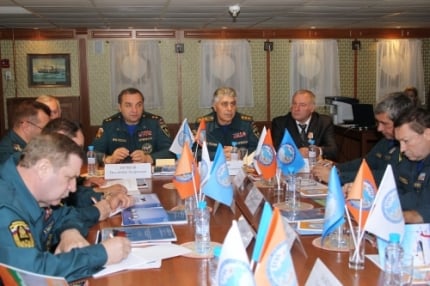
Discussing Russian SAR operations. (c) EMERCOM.
On August 20, the first of ten new Russian search and rescue centers along the Northern Sea Route (NSR) opened in Naryan-Mar in the Nenets Autonomous Okrug (NAO). The governor of the NAO, Igor Fyodorov, and Deputy Minister of Emergency Situations (EMERCOM) Aleksander Chupriyan, opened the center. The EMERCOM sites will stretch from Murmansk, at the westernmost end of the NSR, to Provideniya, in easternmost Russia along the Bering Strait. In between these two locations will be facilities in Arkhangelsk, Dudinka, Pevek, Vorkuta, Nadym, Anadyr, and Tiksi. Most of the people and resources will be concentrated in the three largest centers at Naryan-Mar, which will have 147 employees, Dudinka, which is supposed to open later this year, and Pevek.
In 2009, the Russian government set aside 910 million rubles ($27.1 million) to construct the centers along the route. The sum is quite small because Russia already had a decent amount of infrastructure. Construction began in December 2010. The other nine centers should be open by 2015.
Here is a rudimentary map of the locations:
View NSR Emercom Centers in a larger map
The Barents Observer reports that the Naryan-Mar facility includes a “fire department, a department for search and rescue operations with vehicles and boats, a berth and training facilities.” Russia has even considered using motorcycles in the remote areas of the Arctic to rescue people. Russia is thus making good on the spirit of the Arctic Council’s Search and Rescue Agreement, the first binding agreement under the body’s auspices.

Ewan McGregor on his motorcycle in Siberia – coming to a rescue site near you? (c) Long Way Round
Russia is not just opening SAR centers for the international good. As the country seeks to further its plans for offshore oil and gas, it needs more SAR facilties. Governor Fyodorov stated at the opening ceremony, “We have ambitious plans for shelf exploration. It is no secret that I want such a center to be established in the Amderma settlement.” Amderma is a small settlement with 600 people on the Kara Sea, not too far from the Yamal Peninsula. Here, Gazprom has major plans to extract an estimated 55 trillion cubic meters of gas, making it the world’s largest gas reserve. Russia has an estimated 82% of the high Arctic’s gas reserves, so it is a must that it has SAR facilities in place.
The recent helicopter crash near Scotland’s Shetland Islands that killed four people en route from an oil platform in the North Sea demonstrates that offshore oil exploration even in relatively calmer areas than the Arctic is still a dangerous enterprise. Technology can malfunction and emergency response can be difficult without the right people and equipment. Fortunately, Scotland had many of the necessary SAR facilities at the ready. Police Scotland’s Chief Inspector Angus MacInnes expressed, “The quick and co-ordinated response by the Maritime and Coastguard Agency (MCA), Royal National Lifeboat Institution and other emergency services may have prevented further loss of life in this already tragic incident.” Even with these services, however, UPI reports that a passenger ferry headed to the Orkney Islands, a freighter, and a fishing boat were requested to help search for the missing employees. In the Arctic, it’s doubtful such additional helping hands would be nearby. Russia is therefore ahead of the curve in making sure that adequate search and rescue facilities are in place as shipping activity and oil and gas production are set to grow.
Russia is also acting incredibly quickly in the Arctic, at least by North American standards. Prime Minister Stephen Harper, for instance, announced his desire for six to eight Arctic offshore/patrol ships (AOPS) in 2007. It’s now 2013, and not a single ship has been procured. The only real movement on the CAN$7.4 billion project has been Halifax’s Irving Shipbuilding preparations to design the ships (and this damaging report in April 2013 calling the AOPS a “titanic blunder”).
It’s one thing if a project of the size and scope of the AOPS hasn’t yet been completed. But even Harper’s promise to build a refuelling station in Nanisivik, Nunavut remains unfulfilled. A deepwater port already exists, but it needs to undergo a massive environmental cleanup. The whole project’s cost is now estimated to be CAN$116 million – over four times as much as Russia is spending to create ten search and rescue centers. To be fair, it’s important that all of the environmental regulations are respected as development proceeds, something we can be pretty certain is more the case in Canada than in Russia. But the cleanup was supposed to begin four years ago, and it still hasn’t (the Globe and Mail has more on this story).
Even outside the Arctic, which is prone to the whims of policymakers and commodities cycles, in my hometown of San Francisco, the new, earthquake-proof Bay Bridge only opened yesterday – 24 years after the Loma Prieta earthquake of 1989 made the bridge’s upper deck collapse.
For all of Harper’s Arctic vision, he cannot compete with the efficiency of countries like Russia (and China) in undertaking major projects in the Arctic. This is beneficial when it means that SAR facilities are being built, but worrying if it means that development could proceed more rapaciously and quickly in order to catch commodities cycles at their peaks. In the Arctic, according to Infield Systems, it takes on average over 13 years between field discovery and getting oil into the pipeline. This significant so-called field development lag has inadvertently assisted environmental conservation, however temporarily. A wider availability of infrastructure and facilities could decrease that lag – and jeopardize “inadvertent” conservation.